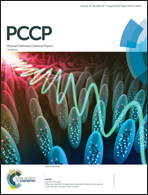Substrate-induced enhancement of the chemical reactivity in metal-supported graphene
Abstract
Graphene is commonly regarded as an inert material. However, it is well known that the presence of defects or substitutional hetero-atoms confers graphene promising catalytic properties. In this work, we use first-principles calculations to show that it is also possible to enhance the chemical reactivity of a graphene layer by simply growing it on an appropriate substrate. Our comprehensive study demonstrates that, in strongly interacting substrates like Rh(111), graphene adopts highly rippled structures that exhibit areas with distinctive chemical behaviors. According to the local coupling with the substrate, we find areas with markedly different adsorption, dissociation and diffusion pathways for both molecular and atomic oxygen, including a significant change in the nature of the adsorbed molecular and dissociated states, and a dramatic reduction (∼60%) of the O2 dissociation energy barrier with respect to free-standing graphene. Our results show that the graphene–metal interaction represents an additional and powerful handle to tailor the graphene chemical properties with potential applications to nano patterning, graphene functionalization and sensing devices.



 Please wait while we load your content...
Please wait while we load your content...